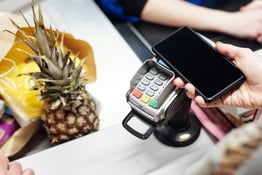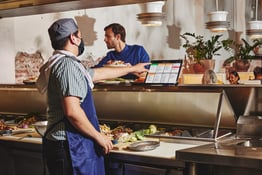Virtual brands boomed during the pandemic, largely out of necessity as off-premise business became king. But even with dining rooms filling back up, the trend appears likely to stick around, offering operators a way to build a second line of revenue using existing resources.
What’s a virtual brand?
Virtual brands are digital restaurants that exist on delivery platforms like Uber Eats, DoorDash, Caviar, and Grubhub. They can launch out of ghost kitchens or existing restaurant kitchens, but typically there’s no physical storefront.
The digital concept brings an opportunity to test out new food ideas and keep kitchens busy during periods where business is slow, often using current kitchen space and staff. Naturally, the barrier to entry is far lower than creating a new brick and mortar. But that doesn’t mean starting a virtual brand comes without challenges. Logistical and strategic planning is required to be successful, including building a craveable menu, integrating with third party delivery platforms, and creating a robust marketing plan to familiarize people to a new brand. For many independent operators, that takes time and manpower that simply doesn’t exist.
In recent years, several companies have emerged seeking to tackle that problem. The idea is to allow operators to license concepts that have already proven success in the delivery market.
“For us smaller independents, it’s really great because people know the brand already, and then we essentially become a station of this brand,” says Victor Tejada, an operator with two restaurants in Philadelphia and New York who also licenses two brands from Meal Outpost. “If you start a new brand on your own, you have to invest in promotion, start an Instagram and Facebook, and put all this energy into it, and maybe you’ll get a few customers in the first weeks. We don’t have the marketing dollars or market knowledge of bigger competitors.”
Combined, the brands Tejada runs out of his two restaurants currently bring in an average of $11,000 a month in revenue. As for many who dabble in the virtual restaurant world, that extra money has become somewhat of a lifeline for Tejada amid rising operating costs.
“I feel like if I didn’t have this money every week, I may have to close my business,” says Tejada. “You can always find solutions, but this is now what’s helping me keep my employees and pay the rent.”
Getting started with a brand licensing platform
Every licensing platform operates a little differently, starting with the types of brands offered. For example, Meal Outpost, founded by two alums from ghost kitchen company Kitchen United, partners solely with established brick and mortar brands, like Mono Mono and Golden Crust, whose menus are designed to thrive in the delivery market.
“We believe in virtual brands, and we believe they'll be here to stay, but I just think there are certain types of brands that make a little more sense to scale,” says co-founder Dustin Mares.
Nextbite, on the other hand, develops its own virtual-only brands, analyzing consumer insights and trends to shape each menu. It currently licenses around 15 different concepts.
“Our goal is to understand the different needs consumers have for delivery and how we can provide something that we know people order during those slower times,” says Mickey Citarella, Nextbite’s vice president of brand. “So we have brands focused on late-night and indulgent food, breakfast brands focused on breakfast burritos or your standard breakfast sandwich, lunch brands that offer sandwiches, wing brands, and burger brands.”
Before licensing a brand, most platforms require operators to complete a general application and basic vetting process, such as providing photos of their restaurant’s kitchen. The goal is to make sure the restaurant has the capacity to host a brand. A good brand fit will maximize a restaurant’s profit potential while enabling the brand to maintain good reviews and ratings.
Choosing the right virtual brand for your restaurant
Operators are advised to choose brands that won’t require much additional SKUs (ingredients) or equipment outside of what their restaurant’s already using. This helps minimize added costs and food waste. In many cases, brands offer some menu flexibility. For example, if a restaurant typically uses brioche, but a brand’s menu calls for potato buns, substitutions may be discussed.
“The next thing to look at is capacity,” says Citarella. “If you’re really busy during dinner, we’ll offer you breakfast brands because we want to be sure the solutions are uplifting slower day parts when you have the capacity to do more.”
Once an operator chooses a brand, Nextbite and Meal Outpost act as the middleman, handling all of the training required to learn the brand. Operators are typically provided with training materials and videos that go over how to prepare and package each menu item. Some platforms will also do check-ins with restaurants to make sure everything is running smoothly.
“We’re constantly monitoring and optimizing the ratings and reviews and key measures, like error rates, and then doing follow-up calls to help them through any problems,” says Citarella.
Brand marketing
Licensing platforms handle most of the marketing required to draw customers to a virtual brand, and that’s arguably the greatest benefit of partnering with one. Restaurants don’t have to pay anything additional out of pocket, as the marketing budget is built into the platforms’ business models.
“We’re setting up all the third party integrations and marketing, and also working with the licensor to say, ‘What have you found to be the most effective way to promote the brand?’, and then we’re also working with third parties when it comes to different trade barriers,” says Mares.
Most of the marketing spend goes towards advertising on third party delivery platforms, but some is also put towards social media. While not required, generally operators are also encouraged to promote the brands they license through their restaurant’s own social media channels. In some cases, operators are allowed to market these brands onsite, too, and even set up ordering windows at their existing restaurants.
“Ultimately we leave it up to the licensor on how guests can purchase from operators, but we’ve seen the power of guests being able to walk onsite and order – there’s a lot of extra revenue to be made,” says Mares, noting that about 75% of brands on Meal Outpost allow host operators to provide onsite ordering experiences in addition to delivery.
As the virtual restaurant industry continues to grow, it’s likely more brands will begin to have a non-virtual presence, according to Mares. Consumers are increasingly showing a demand for transparency. They want to know where the online food they’re ordering is actually coming from and having an onsite presence is part of that. But it’s still far from the norm, and if an operator doesn’t have the staff to handle onsite orders, it’s not a prerequisite.
Payment structure and earning potential
Generally it’s free to license a brand, but operators give licensors a percentage of the total sales.
With Meal Outpost, restaurants pay 10% of total sales each month to licensors. Meal Outpost earns its money through a monthly fee paid by the licensors that ranges from $300 to $700. Some of that money is invested into restaurants’ success, used for tasks like onboarding and brand marketing.
Earnings are subjective to brand and location, but currently, Meal Outpost says all of its restaurant partners are earning a minimum of $4,000 per month, and some of best-performing brands are pulling in $5,000 to $12,000 a week.
With Nextbite, who licenses its own in-house brands, restaurants generally get a 55% cut of total revenue.
“Out of that 55%, food and packaging accounts for about 25%, so our goal is for partners to make a 30% profit on the gross sale,” says Citarella.
The remaining profit goes to Nextbite, some of which is invested back into the restaurants via marketing, onboarding, customer service, and other partner benefits. Nextbite declined to give an earnings’ range, but notes it’s also subjective to the brand and a restaurant’s location.
“I think everyone will try virtual brands at some point,” says Mares. “It’s always going to come down to where you’re at as an operator – the operators we’re working with are those that have the kitchen capacity to bring in another brand.”
Grace Dickinson is a reporter at Back of House. Send tips or inquiries to grace@backofhouse.io.
[Photo courtesy Elle Hughes]





